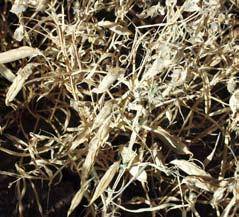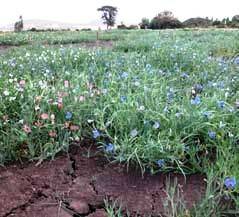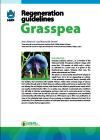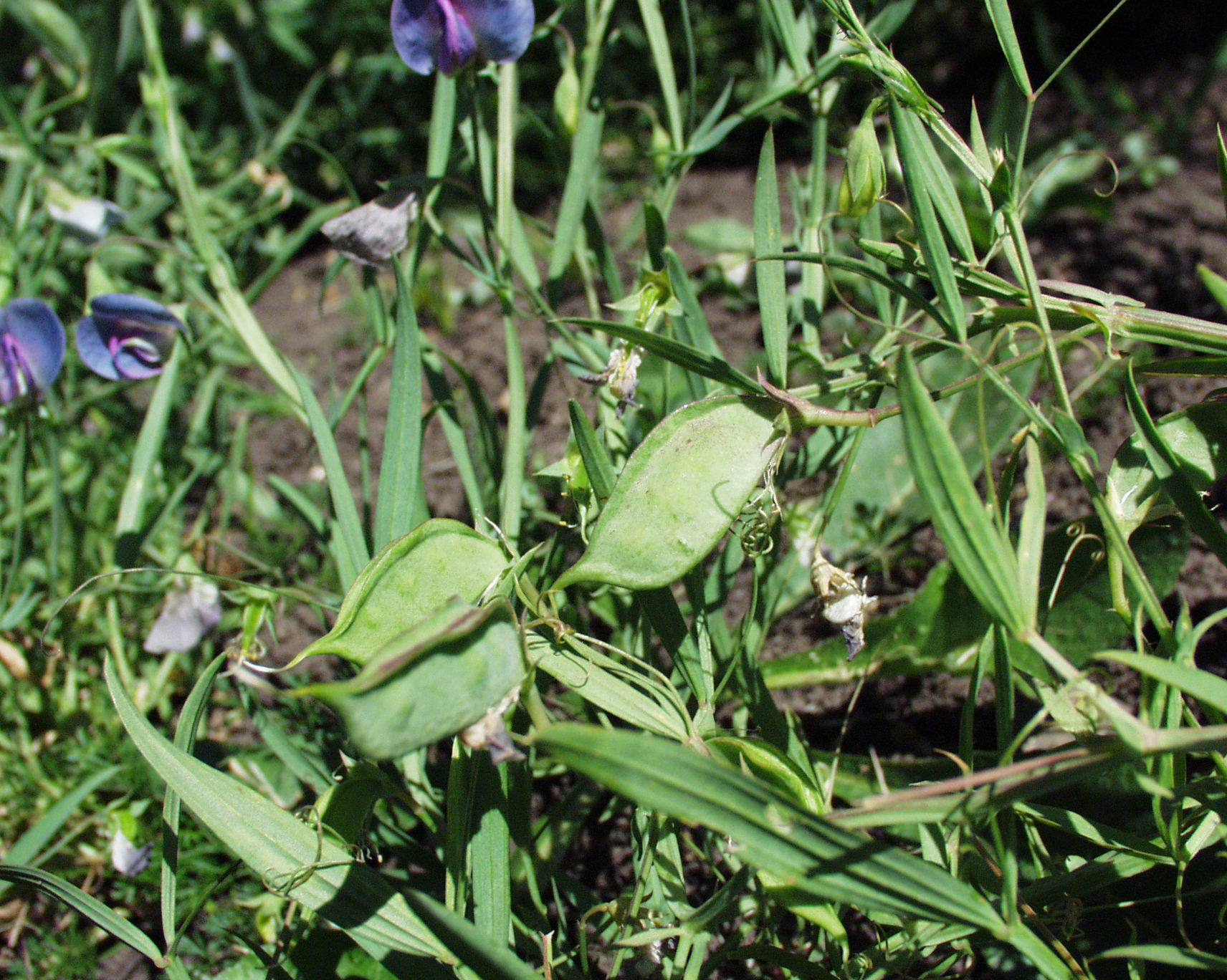Regeneration guidelines for grasspea
|
View regeneration guidelines in full (in PDF) Also available in the following languages: |
The information on this page was extracted from:
Hanson J. and Street K. 2008. Regeneration guidelines: grasspea. In: Dulloo M.E., Thormann I., Jorge M.A. and Hanson J., editors. Crop specific regeneration guidelines [CD-ROM]. CGIAR System-wide Genetic Resource Programme, Rome, Italy. 9 pp.
Before reading the regeneration details for this crop, read the general introduction that gives general guidelines to follow by clicking here.
Introduction
Grasspea (Lathyrus sativus L.) is a member of the Fabaceae family. The genus Lathyrus is large, with more than 150 species, of which only L. sativus is cultivated as a pulse crop. It is grown in the Mediterranean region, Ethiopia, West Asia, the Indian subcontinent and China. The plant is a short, bushy annual herb ranging in height from 20 to 90 cm depending on cultivar. It has pinnately compound leaves, normally with two leaflets, that terminate with tendrils. Flowers, which show a broad range of colours from white through pink to bright blue, are solitary, axillary and borne on peduncles. Pods are oblong, flat and slightly curved, with three to five white to greyish-brown seeds which are usually mottled (Duke 1981). It is a hardy crop, tolerant of extremely dry conditions but still able to tolerate waterlogging and poor soils and is commonly grown on heavy clay vertisols. It does not do well on acid soils. Grasspea is autogamous and considered predominantly self-pollinating. Rahman et al. (1995) report up to 30% cross pollination. In view of this relatively high amount of out-crossing, an isolation distance of at least 20 m (preferably 50 m) between accessions of cultivated grasspea is recommended to maintain genetic integrity during regeneration.
 Grasspea flower. (photo: Jean Hanson/ILRI) |
Preparation for regeneration
When to regenerate
- When seed stocks are <150g or 1000 seeds.
- When percentage germination falls to 90% (preferred). The minimum acceptable germination percentage is 75% (FAO/IPGRI 1994).
Other precautions
A population size of at least 80–100 plants should be used for regeneration of landraces. Unimproved landraces and accessions showing a large variation in seed colour and size are likely to be more variable. Larger population sizes should be used in order to maintain genetic variation within the accession. There are no reported transgenes in grasspea.
Choice of environment and planting
Field selection and preparation
- Select frost-free areas with mean temperatures of around 13°C and more than 300 mm annual rainfall.
- Where possible, select loam or clay soils, especially vertisols; avoid acid soils.
- Do not use fields that were planted with grasspea in the previous 3 years to avoid volunteer plants from earlier plantings.
- Plough and disc-harrow to obtain a well prepared and level seed bed prior to planting. Remove any weeds or grass.
Planting season
- Plant in the rainy season to avoid water stress and ensure good seed production. Planting is often done later in the season to allow seed ripening in the dry season.
|
Grasspea regeneration in isolation plots (photo: Jean Hanson/ILRI) |
Method of regeneration
Planting layout, density and distance
- Aim for a final plant number of 80–100 in plots of about 10 m2 (5 × 2 m) (see photo of plots).
- Plant in 10–15 rows of 2 m long, with rows 30–50 cm apart and 10–20 cm spacing between plants, giving a density of 100–150 plants per plot.
- Use bee proof pollination cages to isolate accessions and prevent insect pollination. This is the most effective way to avoid cross-pollination.
- Use an isolation distance of at least 100m between accessions to reduce any out-crossing to very low levels (1%). Plant accessions of other species that do not hybridize with grasspea or of other genera between the grasspea plots to increase the isolation effect.
Sowing method
Direct sowing for landraces
1. Count the number of seeds to be planted per row and place in separate envelopes/bags. Allow two seeds per hole if enough seeds are available because not all of them will germinate. If there are only a few seeds, plant one seed per hole.
2. Label the plot with the accession number and plot number.
3. Lay out the plots at the chosen row spacing.
4. Mark holes for sowing about 2–5 cm deep, 10–20 cm along the row.
5. Check that the accession number is correct and place the corresponding envelope/bag on the end of the row.
6. Open the envelope and place two seeds per hole at 10–20 cm along the row by hand sowing (see photo). Machine planting is not efficient for such small plots.
 Hand sowing of grasspea. (photo: ILRI)
Grasspea pods (photo: Jean Hanson/ILRI) |
7. Cover with soil and lightly compact the row.
Seedling transfer for accessions with small numbers of seeds
1. Germinate seeds in Petri dishes in an incubator at 25°C with 12-hour light (ISTA 2008).
2. As soon as the radicals start to emerge, plant the young seedlings individually in small pots filled with sterilized compost, peat or forest soil.
3. Label the plot with the accession number, planting date and plot number.
4. Keep the pots away from direct sun but with good light intensity or in a greenhouse.
5. Water carefully so the soil remains moist but not wet.
6. Once seedlings reach 10 cm tall, place pots outside for 1 week so seedlings can harden off; keep the soil moist.
7. Peg out the plots at the chosen row spacing and make holes at 10–20 cm along the row.
8. Transplant seedlings to the field, one seedling per hole, taking care not to damage the roots. Water after transplanting.
Thinning
- If direct sown, thin to one plant per hole at 2–6 weeks after establishment when plants are about 10 cm tall to give a plant density of about 100–150 plants per plot and avoid competition that will result in weak plants and low seed yields. When thinning, do not remove only smaller or weaker plants as this will reduce genetic variation. Thinning can be done at the same time as the first weeding.
Fertilization
- Fertilizer application will depend on soil type and fertility. Follow local recommendations.
- It is possible to grow the crop without fertilizer but direct application of phosphorus in the holes (100 kg DAP/ha) before planting is recommended. Applying 50–60 kg N/ha as a top dressing at early flowering stage will ensure good seed quality.
Crop management
Weed management
- Early growth can be slow so weed by hand 4 weeks after establishment when seedlings are about 10–20 cm tall. Ensure field technicians know what young plants look like so they do not mistake them for weeds.
- Eliminate off-types and plants growing off-row.
Irrigation
- Irrigate the field after sowing and then when needed. Do not allow leaves to wilt at any stage and ensure soil is moist at time of flowering.
Common pests and diseases
Major fungal diseases that attack grasspea are grey mould (Botrytis sp.), rust (Uromyces fabae), powdery mildew (Erysiphe polygoni) and downy mildew (Peronospora lathi-palustris) (Duke 1981; Smartt et al. 1994). Grasspea shows resistance to ascochyta blight caused by Mycosphaerella pinodes (Skiba et al. 2004).
Pest and disease control
Grasspea rarely suffers attacks from pests and diseases when grown in dry rainfed conditions.
Spray with fungicide to control mildew during the rainy season or when using irrigation.

Mature grasspea pods at harvest stage. (photo: Yanpei Wu/ILRI) |
Harvesting
- When equal numbers of seeds are required from each accession, hand harvest plants into cotton/cloth bags for drying before threshing or hand pick when the pods start to turn brown and begin to dry but before fully ripe pods start to dehisce and shatter (Kay 1979) (see photo).
- For large plots, where seeds from all plants within an accession will be mixed, cut the stems close to the ground and loosely roll the plants to allow final ripening and air drying before placing in cotton/cloth bags ready for threshing to separate the seeds from the pods.
- When equal numbers of seeds are required from each accession, collect the pods from each plant in labelled cloth or paper bags with an additional label inside each bag. Use paper bags in dry climates only.
- Thresh the pods on a tarpaulin by gently beating them; return the seeds to their labelled bag.
- Ensure that seed mixing does not occur during threshing.
Post-harvest management
1. Clean the seeds of debris by hand picking, hand winnowing or using a seed blower.
2. Hand pick over the seeds in trays to remove any shriveled, discoloured, infected or damaged seeds from each plant. Incinerate the waste to avoid spread of seed-borne diseases.
3. Compare the harvested seed with original seed of that accession for seed size, seed pattern and primary seed colour to check for mistakes/correspondence.
4. Take equal quantities of seed from each plant and mix in one paper bag labeled inside and out. Once you have all the seeds needed, discard any extra.
5. Retain the bags of each accession in temporary storage until seed drying.
6. Take a sample of the seeds for seed health testing. If the fresh seeds are infected with seed-borne diseases and more original seeds are available for a second regeneration, destroy the seeds by incineration. If no original seeds are available, schedule the seeds for a further regeneration in control ed environmental conditions using agrochemicals to obtain clean seeds.
7. If the seeds are free from pests and diseases, dry them in low relative humidity at 15°C until they reach 3–7% moisture content.
8. Remove the seeds from the drying room, weigh and pack directly into storage containers. Options for medium-term storage include plastic containers or cans with sealed lids for storage in environments with humidity control or laminated aluminium foil packets for storage in environments without humidity control. Use of laminated aluminium foil packets is more suitable for long-term storage. Seal the containers or packets immediately.
9. Sample and test the viability of the seeds and record the results fol owing standard germination methods (ISTA 2008). If viability is high, proceed to storage. If viability is low, reschedule the accession for a further regeneration from the original seeds.
10. Store grasspea seeds in the genebank at 5–10°C in medium-term storage or at -18°C in long-term storage.
Regeneration of wild species of grass pea
- Many of the wild species have hard seed and require scarification before planting to allow imbibition. Gently rub hard seeds between two pieces of sand paper until the seed coat is scarified or, using tweezers with well defined square edges, apply gentle but firm pressure to the seed coat with the arms of the tweezers open to about 2 mm so that a small section of the seed coat will chip off. A scalpel can also be used to chip the seed coat.
- Either direct sowing or seedling transfer can be used (see above) depending on the number of seeds available.
- Most Lathyrus species have plants of a similar size to the cultivated L. sativus and the same planting density and management can be used to regenerate accessions of wild species.
- Some of the wild species are outbreeding and will require a greater isolation distance than the cultivated grasspea (Brahim et al. 2001). Isolation distances of 100 m or pollination cages are recommended for outcrossing wild species.
|
Species |
Growth type |
Breeding system |
|
L. annuus |
Annual |
Inbreeding |
|
From: Brahim et al. (2001) |
||
- Many of the wild species have dehiscent pods, so harvesting time should be earlier than for cultivated species and carefully timed for when the pods start to turn brown and begin to dry but before they dehisce and shatter.

Diversity of grasspea flower colour. (photo: Yanpei Wu/ILRI) |
Monitoring accession identity
Comparisons with previous passport or morphological data
Grasspea accessions are distinguished on the basis of flower, pod and seed traits (Jackson and Yunus 1984). Compare following traits in characterization data:
- Flower colour (see photo)
- Pod markings
- Seed coat pattern
- Primary seed colour
- Stem pigmentation
Documentation during regeneration
The following information should be collected during regeneration:
- Regeneration site name and map/GPS reference
- Name of data collector
- Field/plot/nursery/greenhouse reference
- Accession number; population identification
- Source of seed
- Generation or previous multiplication or regeneration (if generation is not known)
- Preparation of planting materials (pre-treatments)
- Sowing date
- Field layout used
- Field management details (watering, fertilizer, weeding, pest and disease control,
- stresses recorded, others)
- Environmental conditions (altitude, precipitation, soil type, others)
- Emergence in the field or greenhouse (number of plants germinated)
- Number of plants established and harvested
- Isolation method used
- Harvest date and method
- Quantity of seeds harvested/accession
- Comparisons with reference materials (record any identification numbers or references of any samples or herbarium specimens taken from this regeneration plot)
- Post-harvest procedures
References and further reading
Asmussen CB. 1993. Pollination biology of the Sea Pea, Lathyrus japonicus: floral characters and activity and flight patterns of bumblebees. Flora 188:227-237.
Bioversity International, ICARDA. 2009. Key access and utilization descriptors for Lathyrus genetic resources. Bioversity International, Rome, Italy; International Center for Agricultural Research in the Dry Areas, Syria. Available here.
Brahim NB, Combes D, Marrakchi M. 2001. Autogamy and allogamy in genus Lathyrus. Lathyrus Lathyrism Newsletter 2:21–26.
Chekalin NM. 1972. [The evaluation of the degree of the selectivity of fertilization in peavine]. Sel'Skokhozyaistvennaya Biologiya 7 (1):103-107.
Chekalin NM. 1973. Selectivity of fertilization in the grass pea (Lathyrus sativus L.). Soviet Genetics 9 (12):1501-1507.
Chekalin NM. 1975. Character of displaying selective fertilization in self fertilized lines and hybrids of Lathyrus sativus. Sel Semenovod Kiev 30:40-44.
Chekalin NM, Samorodov VN. 1975. Rate of growth of pollen tubes in mutant self pollinating lines of Lathyrus sativus. Sel Semenovod Kiev 29:94-97.
Chekalin NM, Zelenskaia LA. 1973. Inheritance of male sterility in Lathyrus sativus with crossing of sterile plants with fertile pollenizer lines. Sel Semenovod Kiev 23:51-54.
Chowdhury MA, Slinkard AE. 1997. Natural outcrossing in grasspea. Journal of Heredity 88 (2):154-156.
Duke JA. 1981. Handbook of Legumes of World Economic Importance. Plenum Press, New York, USA. pp. 199–265.
FAO/IPGRI. 1994. Genebank Standards. FAO and IPGRI, Rome, Italy. Date accessed: 16 August 2008.
Godt MJW. 1991. Genetic structure, mating patterns, and gene flow in Lathyrus latifolius L. [PhD thesis]: University of Georgia, 145 pp.
Godt MJW, Hamrick JL. 1991. Estimates of outcrossing rates in Lathyrus latifolius populations. Genome 34 (6):988-992.
Godt MJW, Hamrick JL. 1993. Patterns and levels of pollen mediated gene flow in Lathyrus latifolius. Evolution 47 (1):98-110.
Gorodnii NG, Fesenko AF. 1975. Opylenie chiny. [Pollination of Lathyrus pratensis]. 95(3):24-25.
Gutierrez JF, Vaquero F, Vences FJ. 1994. Allopolyploid vs. autopolyploid origins in the genus Lathyrus (Leguminosae). Heredity 73 (1):29-40.
ISTA. 2008. International Rules for Seed Testing. International Seed Testing Association. ISTA Secretariat, Switzerland.
Jackson MT, Yunus AG. 1984. Variation in the grasspea (Lathyrus sativus L.) and wild species. Euphytica 33:549–559.
Kay D. 1979. Food legumes. Tropical Development and Research Institute (TPI). TPI Crop and Product Digest No. 3. TPI London, UK. pp. 26–47.
Piatitskaia LI. 1972. Biology of flowering and viability of pollen of Lathyrus vernus. In Rasteniia Prirodnoi Flory Sibiri Dlia Zelenogo Stroitel'Stva :166-169.
Rahman MM, Kumar J, Rahman MA, Afzal MA. 1995. Natural outcrossing in Lathyrus sativus L. Indian Journal of Genetics 55:204–207.
Skiba B, Ford R, Pang ECK. 2004. Construction of a linkage map based on a Lathyrus sativus backcross population and preliminary investigation of QTLs associated with resistance to ascochyta blight. Theoretical and Applied Genetics 109:1726–1735.
Smartt J, Kaul A, Wolde Amlak Araya, Rahman MM, Kearney J. 1994. Grasspea (Lathyrus sativus L.) as a potentially safe food legume crop. In: Muehlbauer FJ, Kaiser WJ, editors. Expanding the Production and Use of Cool Season Food Legumes. Kluwer Academic Publishers, Dordrecht, Netherlands. pp. 144–155.
Valero M, Youssef A, Vernet P. 1986. Is there polymorphism in the breeding system of Lathyrus latifolius? Kaul, A. K. and Combes, D. (Eds). Lathyrus and Lathyrism. Proceedings of the International Symposium 9-13 September France, New York: Third World Medical Research Foundation, pp. 105-117.
Yunus AG, Jackson MT. 1991. The gene pools of the grasspea (Lathyrus sativus L.). Plant Breeding 106 (4):319-328.
Acknowledgements
These guidelines have been peer reviewed by Prem Mathur, Bioversity International, India; F.J. Muehlbauer, United States Department of Agriculture – Agricultural Research Service (USDA-ARS), USA; and William Erskine, Centre for Legumes in Mediterranean Agriculture (CLIMA), University of Western Australia.
Comments
- No comments found








Leave your comments
Post comment as a guest